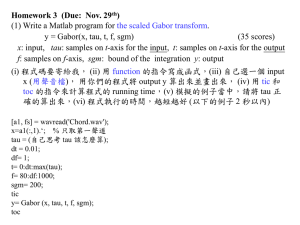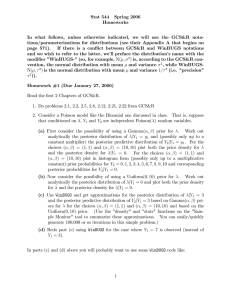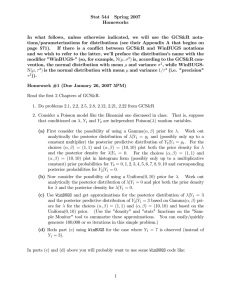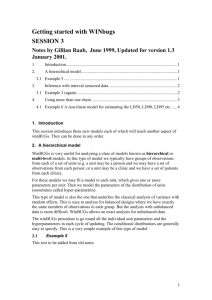session2
advertisement
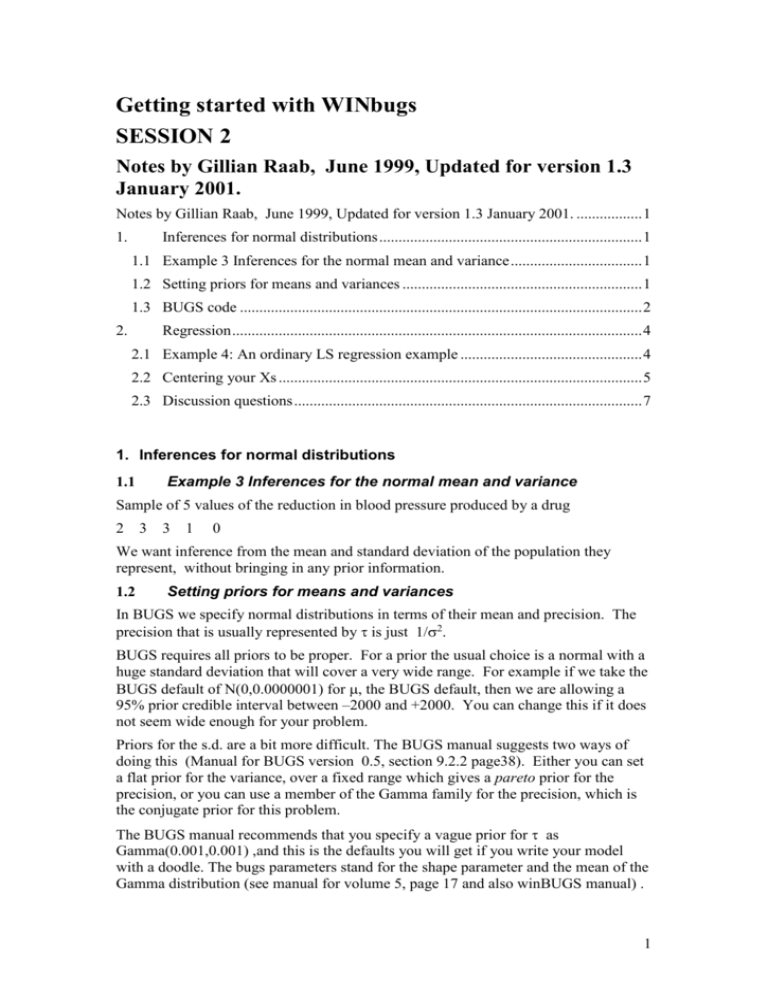
Getting started with WINbugs
SESSION 2
Notes by Gillian Raab, June 1999, Updated for version 1.3
January 2001.
Notes by Gillian Raab, June 1999, Updated for version 1.3 January 2001. ................. 1
1.
Inferences for normal distributions .................................................................... 1
1.1 Example 3 Inferences for the normal mean and variance .................................. 1
1.2 Setting priors for means and variances .............................................................. 1
1.3 BUGS code ........................................................................................................ 2
2.
Regression .......................................................................................................... 4
2.1 Example 4: An ordinary LS regression example ............................................... 4
2.2 Centering your Xs .............................................................................................. 5
2.3 Discussion questions .......................................................................................... 7
1. Inferences for normal distributions
Example 3 Inferences for the normal mean and variance
1.1
Sample of 5 values of the reduction in blood pressure produced by a drug
2
3
3
1
0
We want inference from the mean and standard deviation of the population they
represent, without bringing in any prior information.
1.2
Setting priors for means and variances
In BUGS we specify normal distributions in terms of their mean and precision. The
precision that is usually represented by is just 1/2.
BUGS requires all priors to be proper. For a prior the usual choice is a normal with a
huge standard deviation that will cover a very wide range. For example if we take the
BUGS default of N(0,0.0000001) for , the BUGS default, then we are allowing a
95% prior credible interval between –2000 and +2000. You can change this if it does
not seem wide enough for your problem.
Priors for the s.d. are a bit more difficult. The BUGS manual suggests two ways of
doing this (Manual for BUGS version 0.5, section 9.2.2 page38). Either you can set
a flat prior for the variance, over a fixed range which gives a pareto prior for the
precision, or you can use a member of the Gamma family for the precision, which is
the conjugate prior for this problem.
The BUGS manual recommends that you specify a vague prior for as
Gamma(0.001,0.001) ,and this is the defaults you will get if you write your model
with a doodle. The bugs parameters stand for the shape parameter and the mean of the
Gamma distribution (see manual for volume 5, page 17 and also winBUGS manual) .
1
To help you to check if this prior will be vague enough for the standard deviation in
your problem, or to try out alternatives, the EXCEL spread sheet PRIORS.XLS
(second worksheet) can be used to check it out.
This worksheet can also be used to help you decide on suitable informative priors for
a standard deviation.
See below for explanation. See also information sheet of PRIORS.XLS.
Log variance
1
0.9
0.8
0.7
0.6
0.5
0.4
0.3
0.2
0.1
0
0.0003
0.0002
Prob density
0.00025
0.00015
0.0001
0.00005
0
-18.4
-13.4
-8.47
-3.5
1.474
6.447
Cumulative density
0.02
0.018
0.016
0.014
0.012
0.01
0.008
0.006
0.004
0.002
0
Prob density
1
0.9
0.8
0.7
0.6
0.5
0.4
0.3
0.2
0.1
0
0
19
38
57
76
95
Cumulative density
Standard deviation
Vague prior for as Gamma(0.001,0.001) gives these priors for the s.d. and the
log variance plotted over a range of the s.d. from 0.0001 to 100.
The lower curve for each plot (shown in pink if you are looking at this in colour)
shows the cumulative distribution for the prior and its axis is on the LHS. We can see
that only well below 0.1 of the cumulative distribution lies below 100, so the rest
must be spread out above this. The right hand axis is for the other curve, which is the
probability density. For the s.d. this is in red and peaked at zero, whereas for the log
variance (shown in purple) it is fairly flat, but gently declining, in the range shown.
I hope that you will agree that this is pretty vague.
1.3
BUGS code
Now it is time to use BUGS for this problem. We have 5 repeated values of the
random variable (call it x), so we need to set up a plate in our doodle using the doodle
help menu and write the code from it. Notice that because we use tau to define the
variability, we calculate the standard deviation from tau, with sd being a logical node.
Then use the model specification tool (section 2.1) to define the model. For this
model it is best to load an initial value for the parameter tau – any reasonable values
will do – because geninits sometimes gives negative values. See example below.
Even if you get then wrong the sampler will bring them into the correct range after a
few samples.
Use the updating and sample monitoring tools (sections 2.2 and 2.3) to get inference
about the mean and standard deviation.
2
name:
mean
x[i]
mean
type:
precision
stochastic
tau
density:
dnorm
lower bound
mean
upper bound
model;
{
mean ~ dnorm( 0.0,1.0E-6)
tau ~ dgamma(0.001,0.001)
sd <- sqrt(1 / tau)
for( i in 1 : N ) {
x[i] ~ dnorm(mean,tau)
}
}
tau
sd
x[i]
data;
list(N=5,x=c(2,3,3,1,0))
for(i IN 1 : N)
inits;
list(tau=1)
Summary statistics from one run were
Node mean
mean
1.789
sd
1.625
sd
MC error 2.5%
0.8239 0.007935 0.1641
0.8639 0.01149 0.7757
median
1.787
1.428
97.5%
3.446
3.733
start
1001
1001
sample
9000
9000
This can be compared with frequentist results (from the t and chi-squared
distributions) for the same problem that give the following estimates and confidence
intervals. Your results should be similar.
mean 1.8 95% confidence interval (0.18 to 3.41)
s.d.
1.30 95% confidence interval (0.78 to 3.74)
These results are very similar for the frequentist results for the mean the s.d. The
column MC error tells you to what extent simulation error contributes to the
uncertainty in the estimation of the mean. Simulation errors in the 95% posterior
credible interval (columns 2.5% and 97.5%) will be considerably larger because of the
small numbers in the tails of the distribution.
Examine the trace of all of your samples for the mean with the history button on the
sampling tool. It should look very jagged if the samples are independent. Sketch its
appearance for the mean below.
Is there any evidence of autocorrelation in the chains (use the autoC button)________
If you want you can check answer under session 2 section 1.3 for how it should
look
This is a complicated analysis for a simple problem. But it forms the building block
for later examples.
3
2. Regression
2.1
Example 4: An ordinary LS regression example
The following data need to be fitted by linear regression. They concern the fuel
consumption (Y variable) and weight (X)of cars.
Y[]
3.4
3.8
9.1
2.2
2.6
2.9
2.0
2.7
1.9
3.4
Chart Title
X[]
5.5
5.9
6.5
3.3
3.6
4.6
2.9
3.6
3.1
4.9
10
8
6
Y[]
4
Linear (Y[])
2
0
0
2
4
6
8
The plot shows the data along with the OLS fitted line. We can see that there is what
appears to be a single influential point that may be an outlier. The fitted regression
line (calculated from the EXCEL spreadsheet for example 4) is given by
Coefficients
Intercept
Standar
d Error
-2.329
1.623
1.305
0.356
X Variable 1
t Stat
3.661
We can set up this model in WINbugs as shown here.
name:
shape
tau
1.0E-3
ty pe:
scale
stochastic
1.0E-3
density :
dgamma
lower bound
a
upper bound
P-value
0.0061
model;
{
a ~ dnorm( 0.0,1.0E-6)
b ~ dnorm( 0.0,1.0E-6)
for( i in 1 : N ) {
Y[i] ~ dnorm(mu[i],tau)
}
for( i in 1 : N ) {
mu[i] <- a + b * X[i]
}
b
tau ~ dgamma(0.001,0.001)
sd <- 1 / sqrt(tau)
sd
mu[i]
}
X[i]
data;
Y[i]
for(i IN 1 : N)
tau
Y[] X[]
3.4 5.5
3.8 5.9
9.1 6.5
2.2 3.3
2.6 3.6
2.9 4.6
2.0 2.9
2.7 3.6
1.9 3.1
3.4 4.9
list(N=10)
inits;
list(tau=1)
4
The data are now entered, this time in rectangular format. Highlight the data for Y
and X first, and enter it with the load data button Then highlight the line with N and
enter it. (NOTE : You need to do 2 loads here)
Now generate samples and examine history traces for the estimated slope and
intercept.
Sketch the appearance of the trace for the intercept parameter (a) below.
Is there evidence of autocorrelation in this chain?______________________
If you want you can check answer under session 2 section 2.1 for how it should
look
2.2
Centering your Xs
You will notice that the chains have the appearance of being autocorrelated (look at
how the chains appear, and check the autocorrelations). This has the effect of
increasing the Monte-Carlo error of the intercept a.
The simple trick of centering the X variable sorts out this problem. If we subtract 4
from all the X values, we will still get the same fitted line, but the intercept will now
correspond to the fitted value for what is X=4 in the original data. The regression for
for the new variable (X-4) is
Coefficie Standard
nts
Error
t Stat
P-value
Lower
95%
Upper
95%
Lower
95.0%
Upper
95.0%
Intercept
2.8910
0.4525
6.3896
0.0002
1.8476
3.9344
1.8476
3.9344
X Variable 1
1.3051
0.3565
3.6611
0.0064
0.4831
2.1271
0.4831
2.1271
If you are familiar with regression on EXCEL you could try this on the spread sheet.
To do the same thing in BUGS, all we need to do is to replace the line
mu[i] <- a + b * X[i]
by
mu[i] <- a + b * (X[i]-4)
5
You should now find that there is less autocorrelation in the chains and that the
Monte-Carlo error is much lower. My results were
Node
mean
a
2.887
b
1.306
sd
MC error
2.5%
median
97.5%
start
sample
0.525
0.00901
1.83
2.883
3.944
4001
5000
0.4118
0.006661 0.4849
1.302
2.106
4001
5000
agreeing well with the regression results.
But what about that nasty outlier? Is it perhaps being too influential?
Go to the EXCEL spread sheet for example 4 and see what happens to the fitted line
when you delete the point that is furthest from the line
New estimate of a _____________ Previous estimate____________________
New estimate of b_____________ Previous estimate_____________________
You should have found big changes
If you want you can check answer under session 2 section 2.2 for how it should
look
In ordinary regression we are assuming normally distributed errors. If we think that
there might be outliers, then maybe we would do better to assume that the error
distribution is some long tailed distribution, like a t-distribution. We can do this
easily in winBUGS by replacing the normal distribution for Y[] by a t distribution
with some small number of degrees of freedom. For example we will get really long
tails from a t distribution with 2 degrees of freedom.
This makes the regression more robust to outliers.
6
To do this in winBUGS the line
Y[i] ~ dnorm(mu[i],tau)
10
becomes
8
Y[i] ~ dt(mu[i],tau,2)
6
We now get a very different
4
result, as shown by this output and
graph. The regression is now what
2
we call a resistant regression, that
0
is not unduly influenced by
-2
-1
0
1
outliers. It works because the
likelihood now recognises the
possibility that one might find the odd point in the tails of the distribution.
Node mean
sd
MC error
2.5%
median
97.5%
start
sample
a
2.677
0.09927
0.001141
2.49
2.673
2.881
4001
18000
b
0.5994
0.09314
9.461E-4
0.4205
0.5967
0.795
4001
18000
2
3
You could experiment with different values of the degrees of freedom for your t
distribution and see how your slope parameter changes.
How does this compare with the fitted line with one data point removed?
_________________________________________________________
If you want you can check answer under session 2 section 2.2
2.3
Discussion questions
How would one select a value of t in practice?
Model choice is part of the prior, so should it be chosen before we see the data?
Could we use model averaging technique by allowing a variety of different t
distributions to contribute to the posterior?
How might one set this up?
Some hints are in answers under session 2 section 2.3
7


